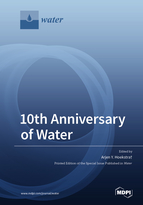10th Anniversary of Water
A special issue of Water (ISSN 2073-4441).
Deadline for manuscript submissions: closed (31 December 2018) | Viewed by 127076
Special Issue Editor
Interests: water resources management; water footprint assessment; sustainable development; water-food-energy nexus
Special Issues, Collections and Topics in MDPI journals
Special Issue Information
Dear Colleagues,
First issued in 2009, Water is celebrating our 10th anniversary this year. Thanks to all dedicated researchers, reviewers, and editors, Water has become a popular outlet for cutting-edge research in the broad field of water science, technology, management, and governance. The open-access format has proven to be attractive, and authors highly value the quick handling of papers, higher visibility and citation, as well as free and unlimited access to the new papers. After ten years, Water has become an established journal in the field.
This Special Issue is set up to mark the 10th anniversary of Water. It is devoted to the publication of comprehensive reviews encompassing the most significant developments in the realm of water sciences in the last decade. Contributions to this Special Issue of Water will be accepted by the editorial office, the Editor-in-Chief, and editorial board members by invitation only.
Prof. Dr. Arjen Y. Hoekstra
Guest Editor
Manuscript Submission Information
Manuscripts should be submitted online at www.mdpi.com by registering and logging in to this website. Once you are registered, click here to go to the submission form. Manuscripts can be submitted until the deadline. All submissions that pass pre-check are peer-reviewed. Accepted papers will be published continuously in the journal (as soon as accepted) and will be listed together on the special issue website. Research articles, review articles as well as short communications are invited. For planned papers, a title and short abstract (about 100 words) can be sent to the Editorial Office for announcement on this website.
Submitted manuscripts should not have been published previously, nor be under consideration for publication elsewhere (except conference proceedings papers). All manuscripts are thoroughly refereed through a single-blind peer-review process. A guide for authors and other relevant information for submission of manuscripts is available on the Instructions for Authors page. Water is an international peer-reviewed open access semimonthly journal published by MDPI.
Please visit the Instructions for Authors page before submitting a manuscript. The Article Processing Charge (APC) for publication in this open access journal is 2600 CHF (Swiss Francs). Submitted papers should be well formatted and use good English. Authors may use MDPI's English editing service prior to publication or during author revisions.






